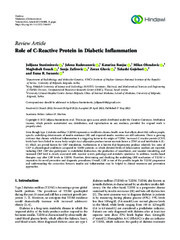| dc.creator | Stanimirović, Julijana | |
| dc.creator | Radovanović, Jelena | |
| dc.creator | Banjac, Katarina | |
| dc.creator | Obradović, Milan M. | |
| dc.creator | Essack, Magbubah | |
| dc.creator | Zafirović, Sonja | |
| dc.creator | Gluvić, Zoran | |
| dc.creator | Gojobori, Takashi | |
| dc.creator | Isenović, Esma R. | |
| dc.date.accessioned | 2022-06-06T09:17:07Z | |
| dc.date.available | 2022-06-06T09:17:07Z | |
| dc.date.issued | 2022 | |
| dc.identifier.issn | 0962-9351 | |
| dc.identifier.uri | https://vinar.vin.bg.ac.rs/handle/123456789/10285 | |
| dc.description.abstract | Even though type 2 diabetes mellitus (T2DM) represents a worldwide chronic health issue that affects about 462 million people, specific underlying determinants of insulin resistance (IR) and impaired insulin secretion are still unknown. There is growing evidence that chronic subclinical inflammation is a triggering factor in the origin of T2DM. Increased C-reactive protein (CRP) levels have been linked to excess body weight since adipocytes produce tumor necrosis factor α (TNF-α) and interleukin 6 (IL-6), which are pivotal factors for CRP stimulation. Furthermore, it is known that hepatocytes produce relatively low rates of CRP in physiological conditions compared to T2DM patients, in which elevated levels of inflammatory markers are reported, including CRP. CRP also participates in endothelial dysfunction, the production of vasodilators, and vascular remodeling, and increased CRP level is closely associated with vascular system pathology and metabolic syndrome. In addition, insulin-based therapies may alter CRP levels in T2DM. Therefore, determining and clarifying the underlying CRP mechanism of T2DM is imperative for novel preventive and diagnostic procedures. Overall, CRP is one of the possible targets for T2DM progression and understanding the connection between insulin and inflammation may be helpful in clinical treatment and prevention approaches. | en |
| dc.language | en | |
| dc.relation | info:eu-repo/grantAgreement/MESTD/inst-2020/200017/RS// | |
| dc.relation | KAUST [OSR#4129] | |
| dc.relation | KAUST Office of Sponsored Research (OSR) [No. FCC/1/ 1976-20-01] | |
| dc.relation | TG by the King Abdullah University of Science and Technology (KAUST) Base Research Fund [BAS/1/ 1059-01-01] | |
| dc.rights | openAccess | |
| dc.rights.uri | https://creativecommons.org/licenses/by/4.0/ | |
| dc.source | Mediators of Inflammation | |
| dc.title | Role of C-Reactive Protein in Diabetic Inflammation | |
| dc.type | article | en |
| dc.rights.license | BY | |
| dc.citation.volume | 2022 | |
| dc.citation.spage | e3706508 | |
| dc.identifier.wos | 00080512770000 | |
| dc.identifier.doi | 10.1155/2022/3706508 | |
| dc.identifier.pmid | 35620114 | |
| dc.type.version | publishedVersion | |
| dc.identifier.scopus | 2-s2.0-85130954989 | |
| dc.identifier.fulltext | http://vinar.vin.bg.ac.rs/bitstream/id/26546/3706508.pdf | |

